If there is one question that has gripped Leeds United fans in the last few weeks, it is who will start for the Yorkshire side in the next fixture? Patrick Bamford or Eddie Nketiah. The topic has picked up so much heat that it has almost taken precedence over the massive expectation of securing automatic promotion to the Premier League with Marcelo Bielsa’s second season in charge. Recent performances have seen Leeds United, a side known for their ultra-offensive philosophy under the Argentine, in the midst of a goal drought. Consequently, the two centre forwards have come under scrutiny.
Bamford has been the regular number nine at the club, leading Bielsa’s attack since last season. His experience and personality has gained the trust of the fans over the years, but he has struggled to find the back of the net despite being fed with chances. Nketiah is the 20-year-old addition to Bielsa’s roster, on loan from Arsenal, after being tussled by rival teams in the previous transfer window. Having a lot of technical abilities and goal-scoring potential, he was brought in with the promise of more game-time with the Championship side but is still adapting on Bielsa’s watch to his rigorous methodology. His goal tally almost matches that of Bamford’s but is yet to prove himself worthy enough to decisively replace Bamford. An idea is to play both, but how practical is it really?
In this scout report, we will examine both players in-depth and investigate how they fit Bielsa’s tactics, comparing their statistics in this tactical analysis. Note that the statistics used in this analysis were collected excluding the previous league fixture against Sheffield Wednesday.
xG overview
First and foremost, let us look at a metric that has become a contemporary cornerstone of quantifying an attacker’s efficiency in front of goal: Expected goals. It is Nketiah who steals the show with an xG of 0.75, edging past Bamford’s xG of 0.61. Despite having played only 430 minutes this season, Nketiah with five goals has been more clinical than Bamford who has not made the most of his chances, scoring four times in 1044 minutes he has played (including the Sheffield Wednesday game).
In 90 minutes, Nketiah also manages 3.4 shots on target, marginally more than Bamford with 3.12. Nketiah has played only two full 90-minute games, both in the EFL Cup, against Salford and Stoke City. Despite having lesser minutes on the pitch as a centre forward, Nketiah averages 5.94 touches in the box per 90 minutes compared to Bamford with 4.36 touches. It makes sense why a large number of Leeds fans prefer to see Nketiah starting over Bamford, especially after he secured the crucial equaliser against Preston North End having come on for Bamford in the 77th minute.
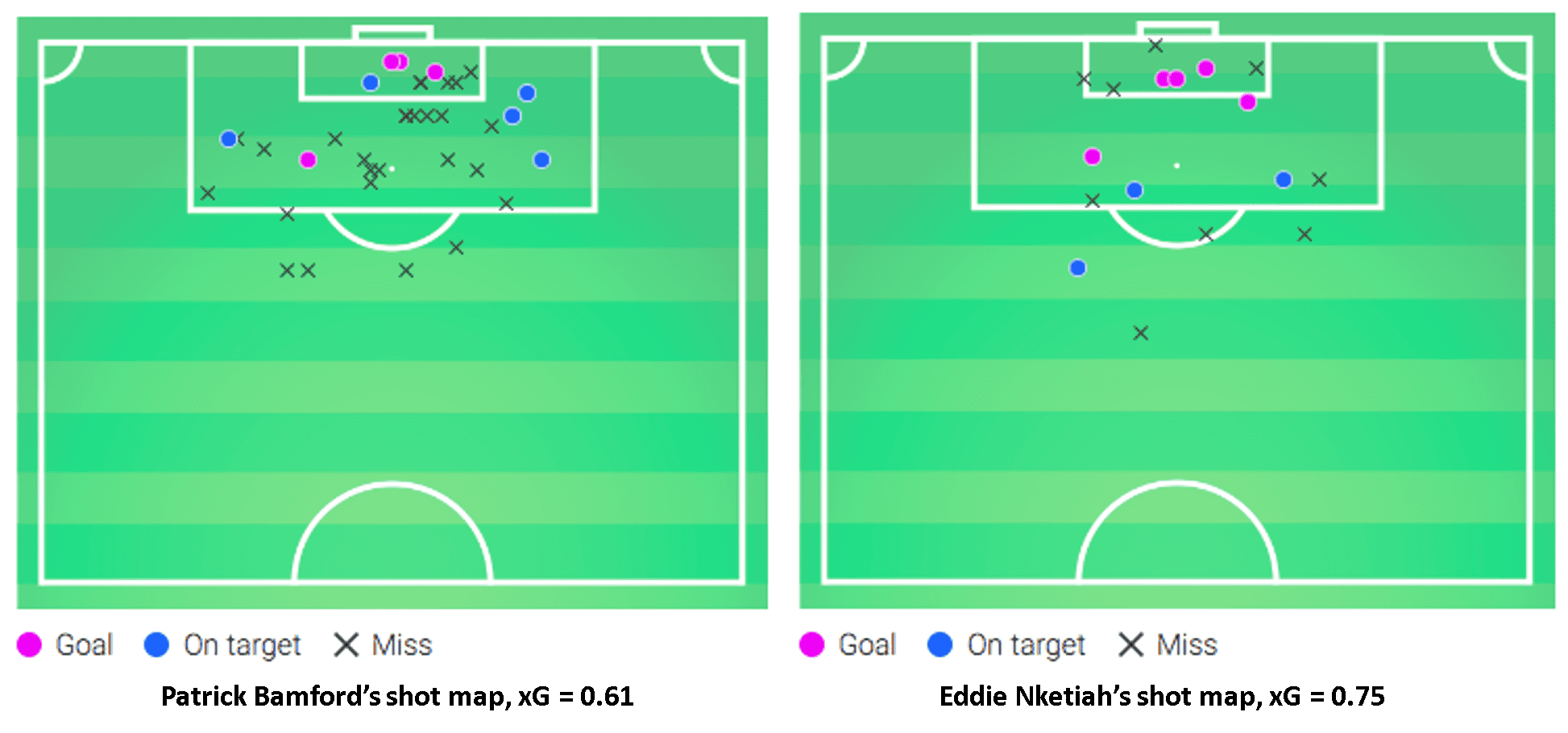
If we compare the shot maps of the two, however, we see a striking similarity in the positions from where the two have scored, most being in the 6-yard box and one in the 18-yard box for both. Bamford has been quite unlucky in front of goal missing some chances with very high xG values on the shots. The away game against Charlton which Leeds lost 1-0, saw both having great opportunities to equalise as we see in the images below but were unable to convert their chances resulting in Bielsa’s side dropping points in a game that was almost entirely played in Charlton’s half.
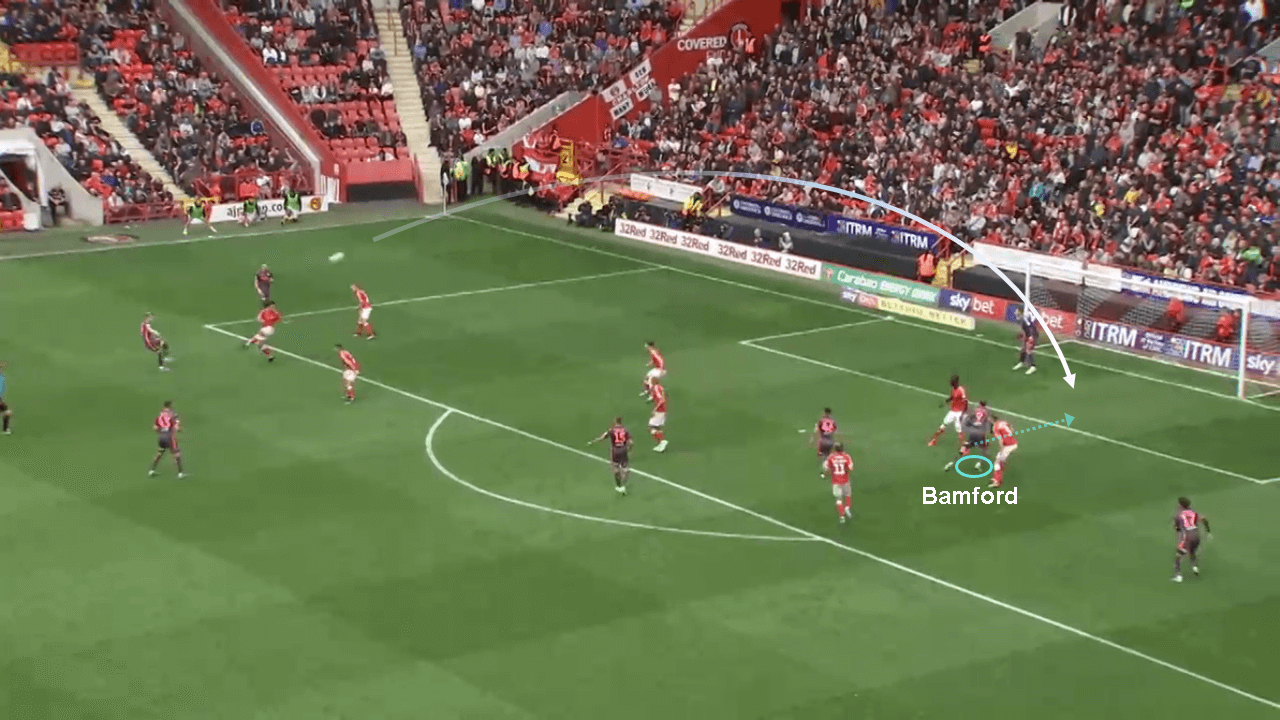
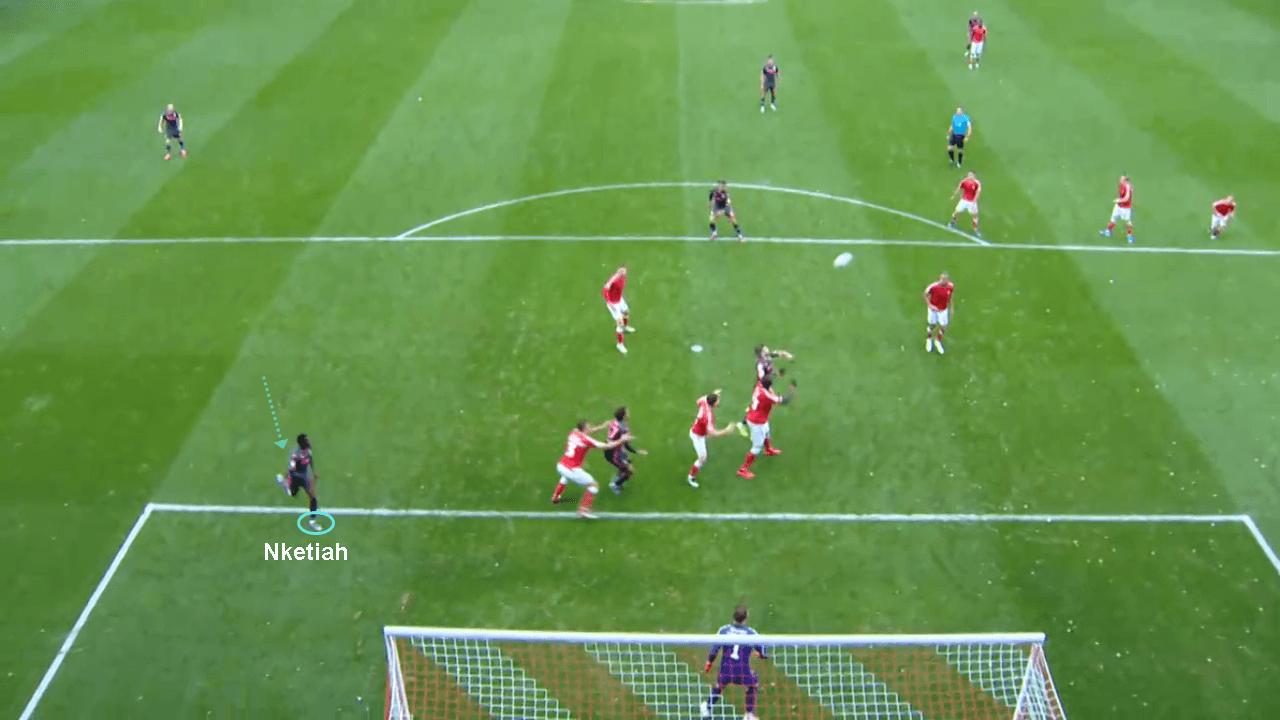
But from the statistics alone, we can see that Nketiah creates double the number of chances than Bamford and stands out with four times the conversion rate, making him the more reliable option to steer Leeds out of their goalless doldrums.
Attacking, passing and defending characteristics
Let us now compare the two players in the three areas. We have already seen how we can rate them purely based on xG, but it would be underdeveloped to draw conclusions solely based on one metric. For example, the expected assists tilts more in favour of Bamford. An xA value of 0.13 compared to Nketiah with an xA of 0.06 shows that the former is more likely to set his teammates up for a goal. In fact, Bamford has averaged 0.09 assists per 90 minutes this season while Nketiah is yet to provide an assist. Nketiah dribbles more than Bamford, making the most of his technical abilities. Nketiah averages 3.61 dribbles per game but with 29.4% success, compared to Bamford who attempts 1.39 dribbles but more efficiently with 46.7% success.
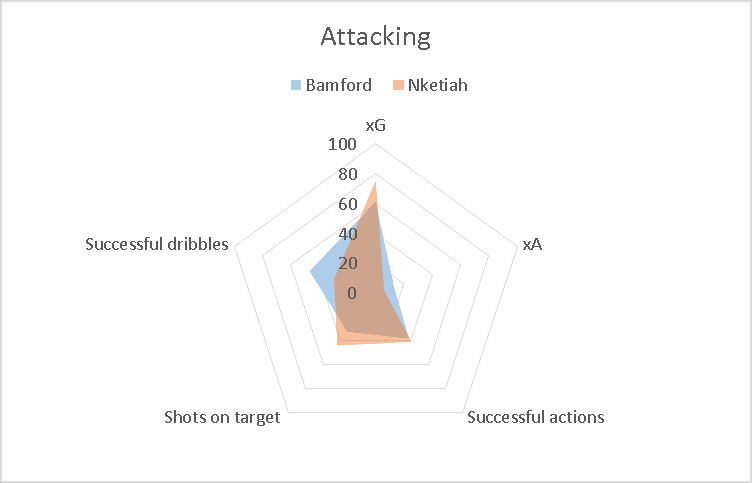
If we compare passing numbers, Bamford is a better crosser of the ball with a higher tendency to drift into wide areas although Nketiah averages more crosses (1.7) per 90 minutes than Bamford (0.19). Bamford is better at playing passes into the final third than Nketiah which is heavily based on his style of play which we will discuss further.
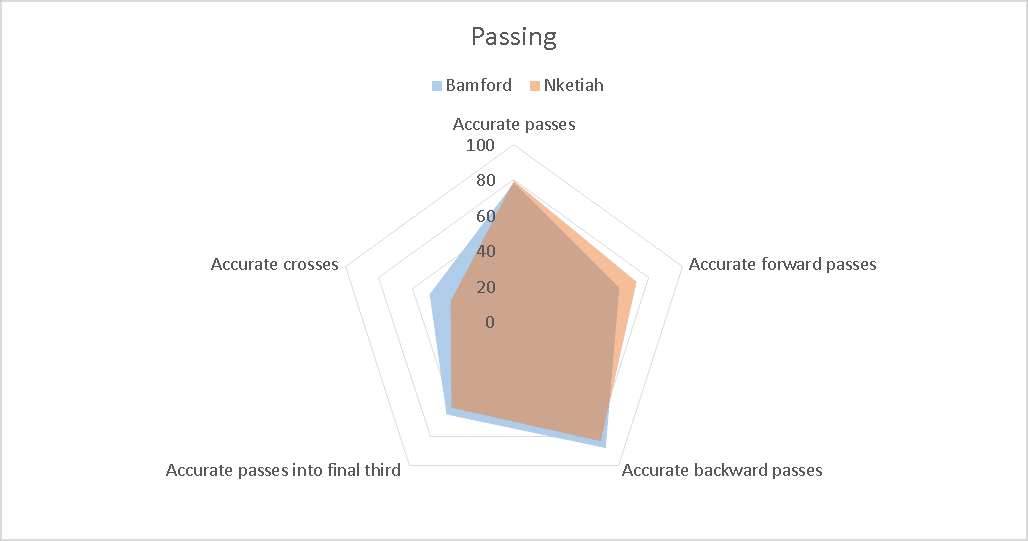
Defensively, we see that Bamford is a more physical presence, winning his aerial duels which again contributes to their style of play. Bamford is also more efficient at recovering the ball in the opposition half although, as Bielsa himself admitted in his press conference, ‘Nketiah runs more than Bamford.’
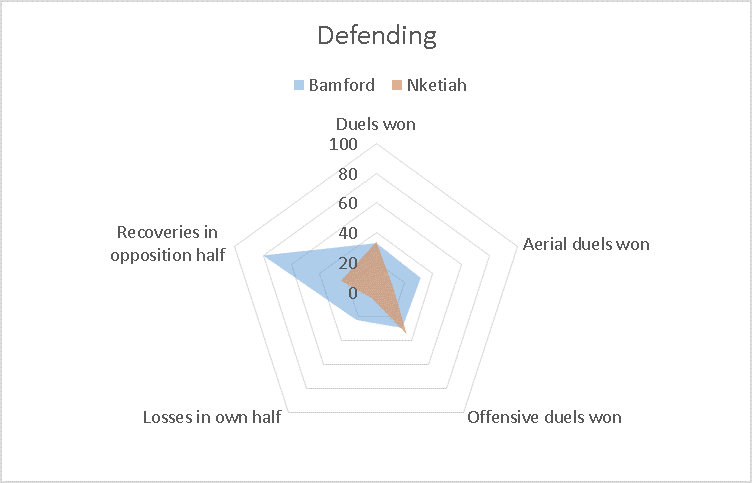
Style of play
Upon being questioned about why Bielsa chooses to start Bamford over Nketiah despite statistical evidence suggested otherwise, the manager claims Bamford offers a lot more to Leeds in their attacking organisation. Let’s examine how:
Nketiah has a tendency to start high between the central defenders, pushing the defensive line back, and then asking for the ball in the space in front of the defence. He usually lays it off with his first touch to a team-mate nearby and then continues to make movements in behind by the space he creates dragging defenders out of position. His technical ability on the ball enables him to receive in tight spaces and link up with teammates. By dropping deeper from an advanced position, he is able to capitalise on the numerical superiority created and works his way up with his team in possession.
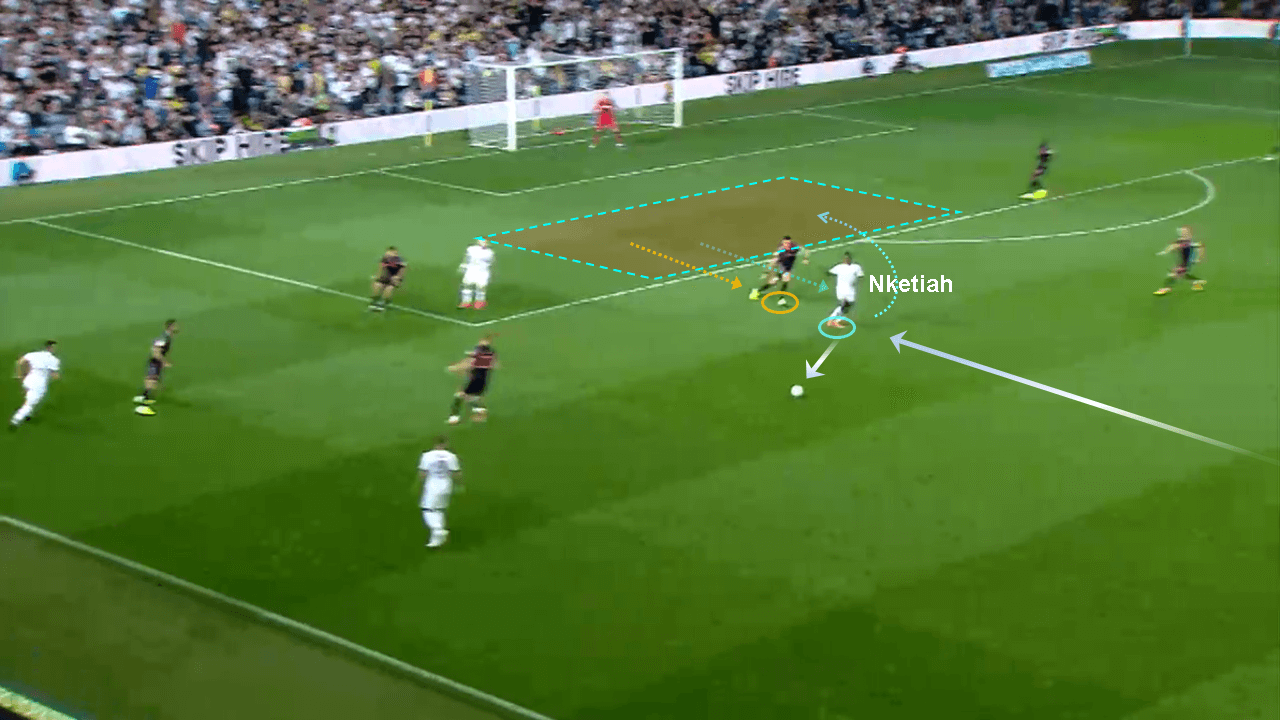
Bamford, on the other hand, is a true definition of a lone striker. When the ball is played to him, he is able to hold it high up using his physical attributes and pivot around the defender to create space for himself. He rarely lays it off with his first touch, yet by holding the ball without being dispossessed, he makes time and space for his teammates to make runs forward. He is then able to find options to build-up play himself.

In the graphics below we see how Bamford is able to control the tempo of play by holding the ball with effective body positioning allowing his teammates to burst forward into advanced positions. Bamford prefers to operate on the right side, especially in the right half-space from where he feels comfortable at initiating plays having been fed the ball from the defence. Although Bamford gets dispossessed 1.9 times per game, as opposed to Nketiah who gets dispossessed 0.6 times per game, Bamford’s ability to secure the ball in dangerous positions creates more opportunities for his teammates to work off.

Positional comparison
Following the discussion on the styles of play of both players, if we compare the heatmaps of the two, we see that Bamford is heavily centred on the right half-space where he feels most comfortable operating in. He is able to drift wide to the right on attacking transitions and receive the ball holding it for his teammates to advance forward. These characteristics make Bamford a very central presence in the attacking organisation as he is a very reliable target player.
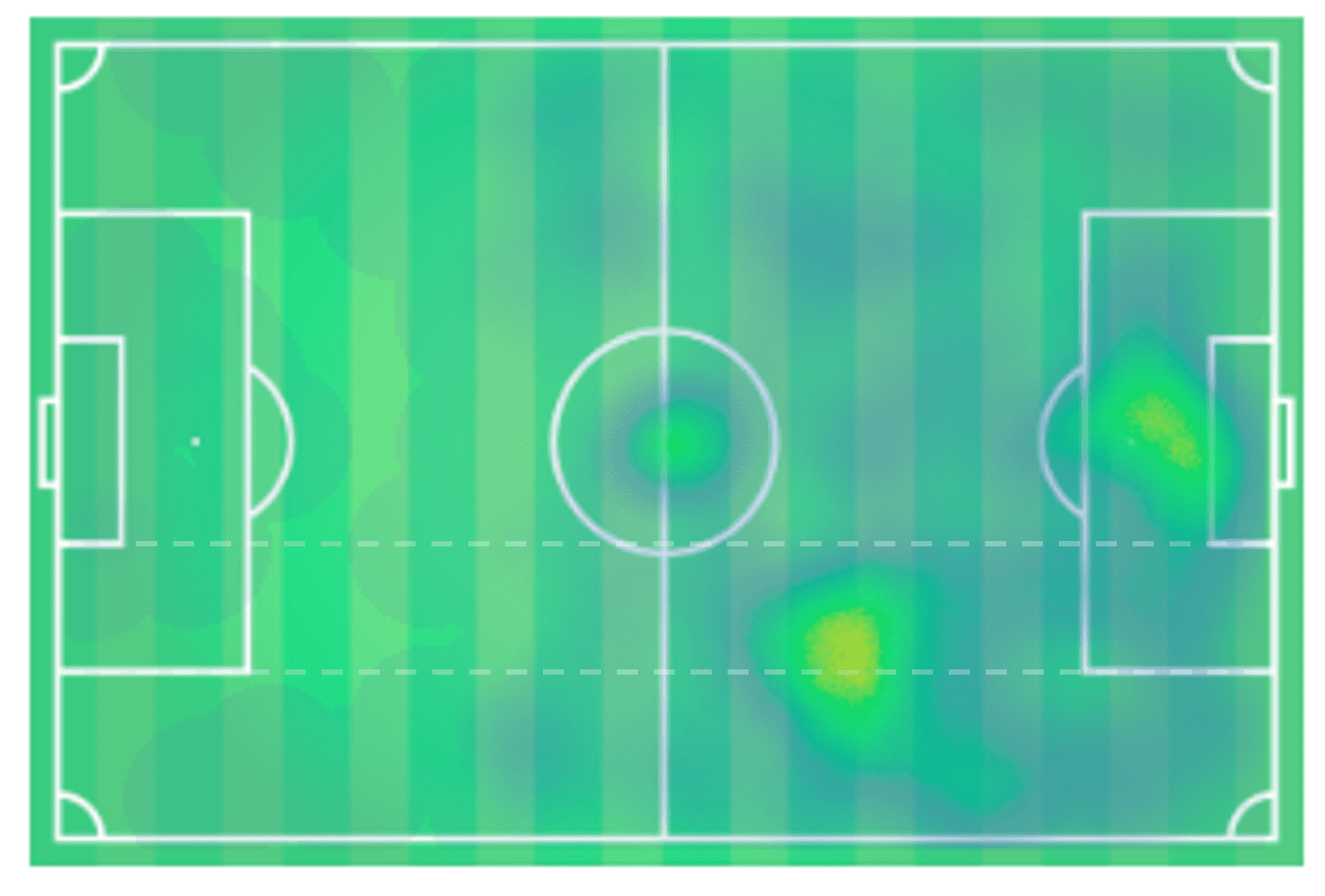
The reason for this is his physicality. At 185 centimetres he is able to win the aerial duels better than Nketiah who measures 175 centimetres in height. Bamford is also more experienced playing against defenders in the Championship. Being able to win the aerial duels in the ‘hole’ against defenders is a huge advantage for teams to be able to play forward, which justifies why the captain Liam Cooper has defended Bamford starting for Leeds citing his contribution in the buildup. The statistics support this as Bamford receives more passes (11.86) than Nketiah (10.61) in a 90-minute game.
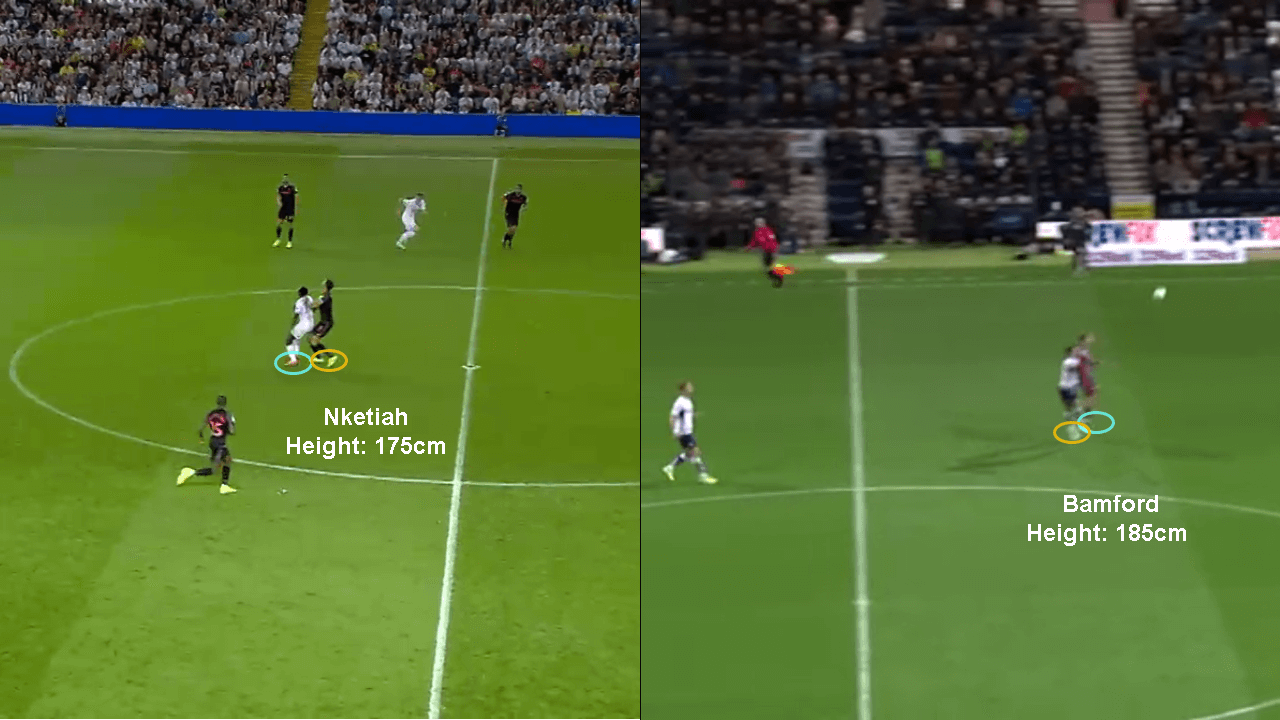
Nketiah’s heatmap, on the other hand, shows how frequently he drops deeper into both the half spaces to combine with his teammates with quick combination passes. Both the strikers work defensively to control the centre of the pitch without the ball making them effective while pressing from the front. Nketiah has far lesser unsuccessful short passes (1.6) than Bamford (2.9) per 90 minutes.
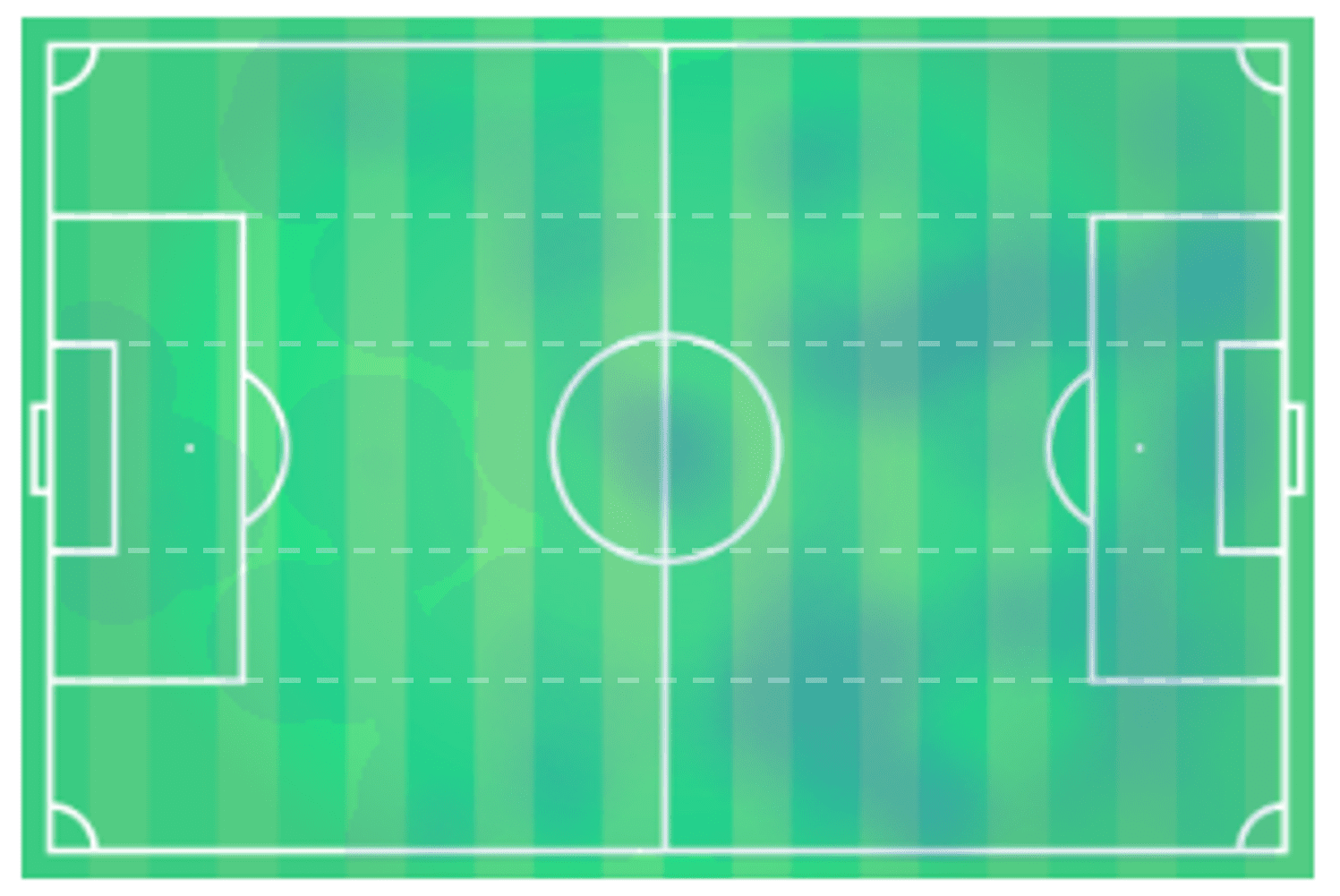
Nketiah combines better with support using short passes and creating numerical superiority but Bamford is able to play effectively even under numerical inferiority.

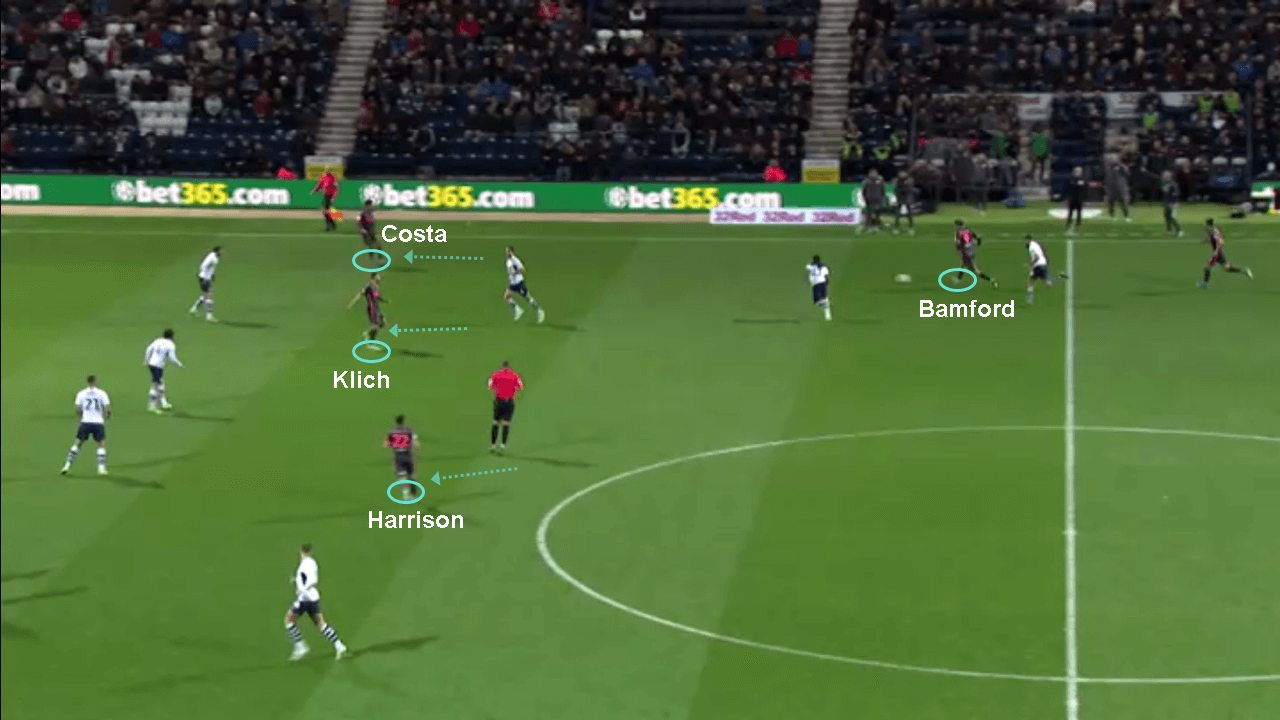
How do both fit in Bielsa’s tactical systems
We are aware that the Argentine’s principles of play involve dynamic rotations in possession, high intensity in pressing and recovering the ball high up when lost and explosive transitions. Tactically, Bielsa deploys ‘un enganche y tres punta’ in lining up his attack, which means most of his formation involves three forwards that operate in front of a creative attacking midfielder.
In his previous teams, the forwards who played the role of the central striker were Fernando Llorente at Athletic Bilbao during the 2011/12 season and André-Pierre Gignac at Marseille during the 2013/14 season. If we compare both their stats, we see very similar figures to that of Bamford with approximately three shots per game, 0.7 dribbles per game and 1.4 aerial duels won. This could possibly explain why Bamford’s playing style suits Bielsa’s tactical system better for a single central striker. Nketiah’s analysis shows that he performs better with support around him or alongside him. One of his noteworthy performances was the 2-2 comeback against Stoke City where Bielsa deployed a 3-1-4-2 system with him and Jack Clarke upfront.
The most common formation used by Bielsa this season, and for the majority of last season was the 4-1-4-1 with Kalvin Philips operating in the hole. This allows two advanced midfielders to support the striker which is crucial for a player like Nketiah to be effective. The wingers, Jack Harrison and Hélder Costa have also performed consistently in attack with the former completing the most number of dribbles in the Championship and the latter combining well with Nketiah assisting his goal against Salford.
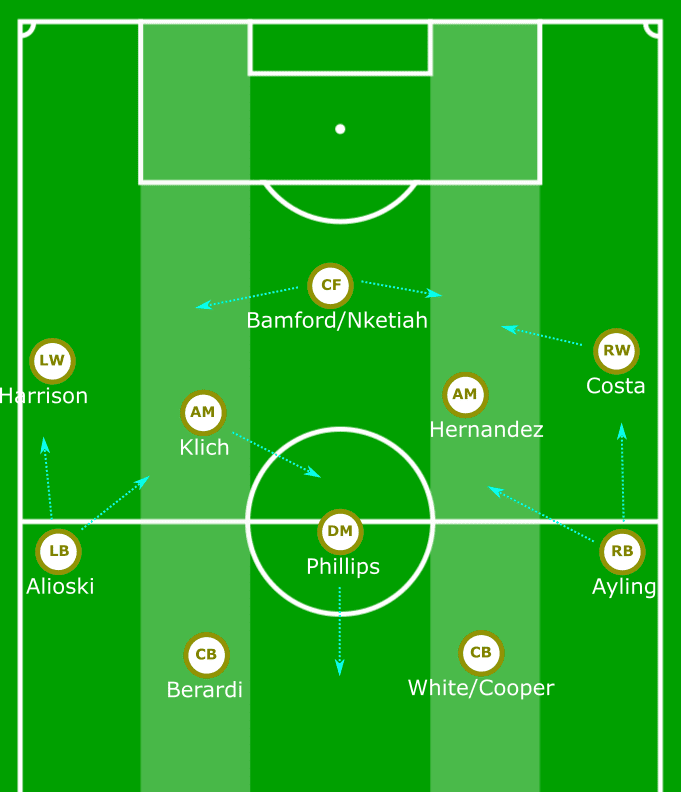
Bielsa also uses the revered 3-3-1-3 formation when the opposition plays with one less forward. This system requires plenty of work by the wingbacks to cover the spaces left during transition. At the expense of utilising an extra player as a centreback, this system sacrifices a player in the attack placing a lot of responsibility on the four attacking players to organise the attacks. A player like Bamford is better suited to hold the ball up front in such a system, buying time for the wingbacks to dart forward and overload the wide areas. We saw this system deployed against Sheffield Wednesday that ended in a stalemate.
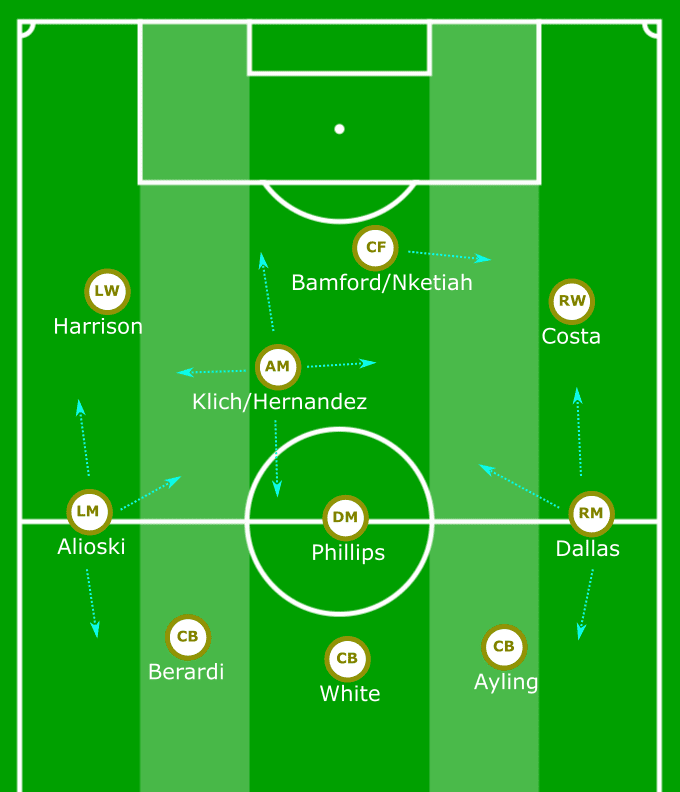
Possible solutions
As Bielsa stated in his most recent press conference, the responsibility of scoring goals cannot fall solely on the number nine. There is a lot of truth in this comment as most of Leeds issues began after their attacking lynchpin or enganche Pablo Hernández got side-lined. If we take away Nketiah and Bamford, the rest of Leeds’ squad have eight league goals between them, none more than two which shows that the squad is over-reliant on their number nine to find the goals for them.
Another key issue is that Leeds have scored 59% of their goals from open play and only 18% from set-pieces. Out of the goals scored, only 6% have been scored from counter-attacks which is a golden opportunity for others on the squad to get on the score sheet. Leeds don’t take enough shots from outside the box, as claimed by the manager himself. These figures suggest that Leeds have a better probability to create goals by working on issues other than their centre forward at the moment.
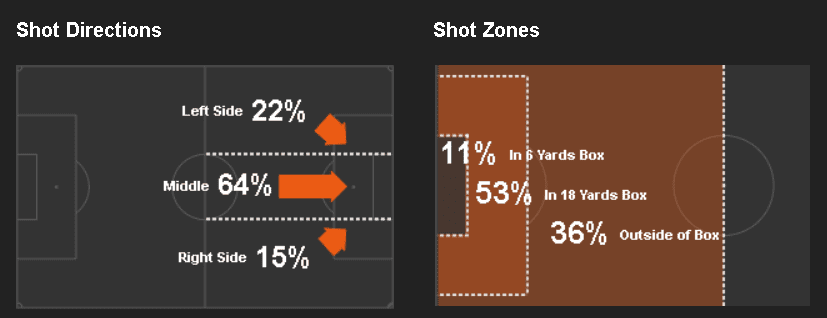
One of the suggestions floating around the press and put forth by the fans is to play both Bamford and Nketiah together. As simple as it sounds, we can see why although both have their own strengths, the solution to Leeds’ goal drought is a bit more complicated. In the game against Charlton, we saw Nketiah brought on at half time which meant they both did actually play together for about 20 minutes.
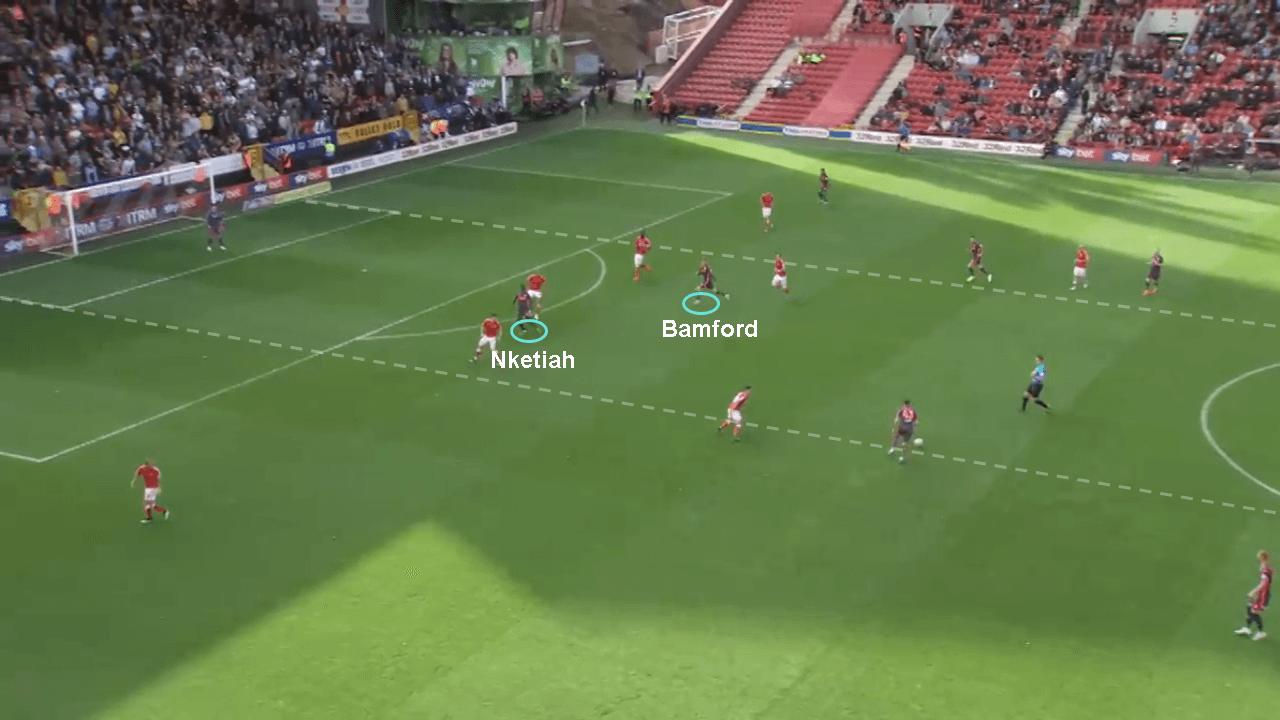
Both the players have a tendency to occupy central areas making them effectively compete for the same space. Bielsa has opened up to the possibility to play Bamford behind Nketiah but we are yet to see this in practice. The similarities between the two players in their attacking movements is what gets in the way. In this graphic below we see how both of them close down on the same space looking for the ball and end up sandwiching Costa leaving the vital space behind the defence without any threat.
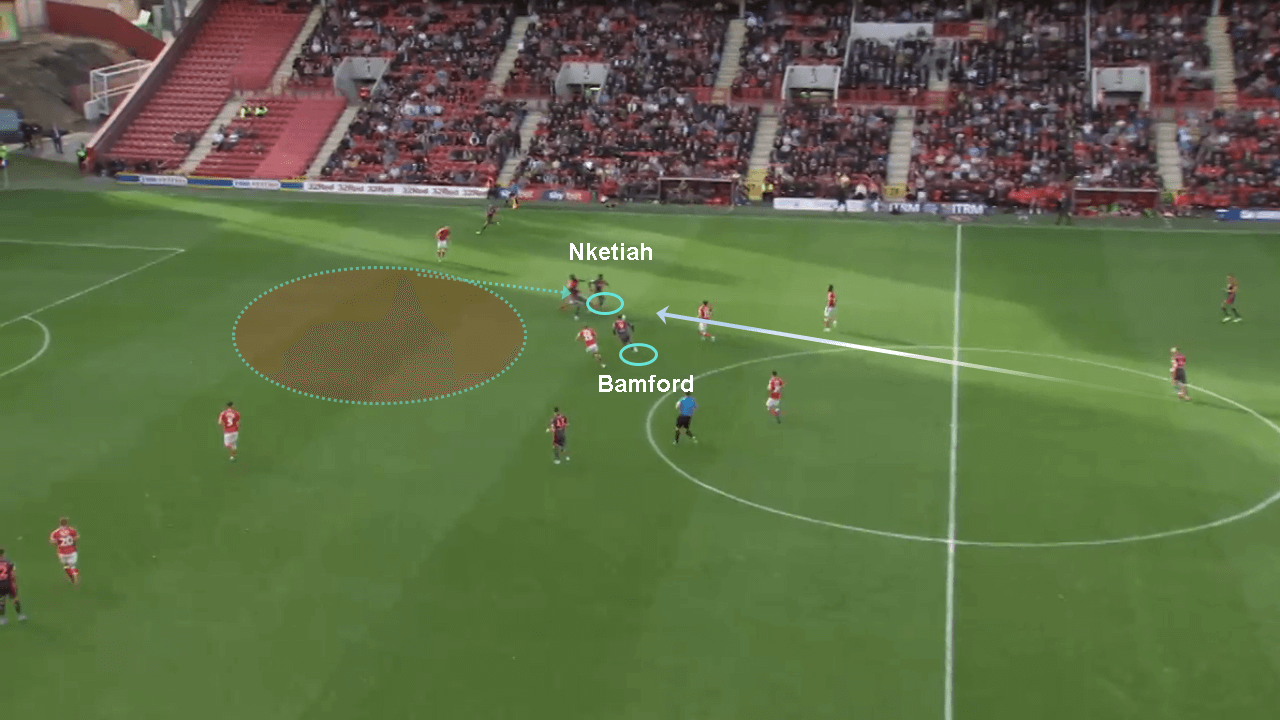
There is plenty of work to be done on the training pitch to see them both utilised effectively in Bielsa’s system. One solution could be utilising them in a two-striker system similar to the one used against Stoke City, but this would mean compromising on a defensive player which carries its own risks. A two-striker system also happens to stray away from Bielsa’s orthodox approach to the game. Nevertheless, it could be a possibility especially against teams who will plan to defend deep at Elland Road as most teams have resorted to last season. Being defensively solid with the likes of Ben White and Kalvin Phillips, and Liam Cooper returning from injury increases the likelihood that we could witness this.
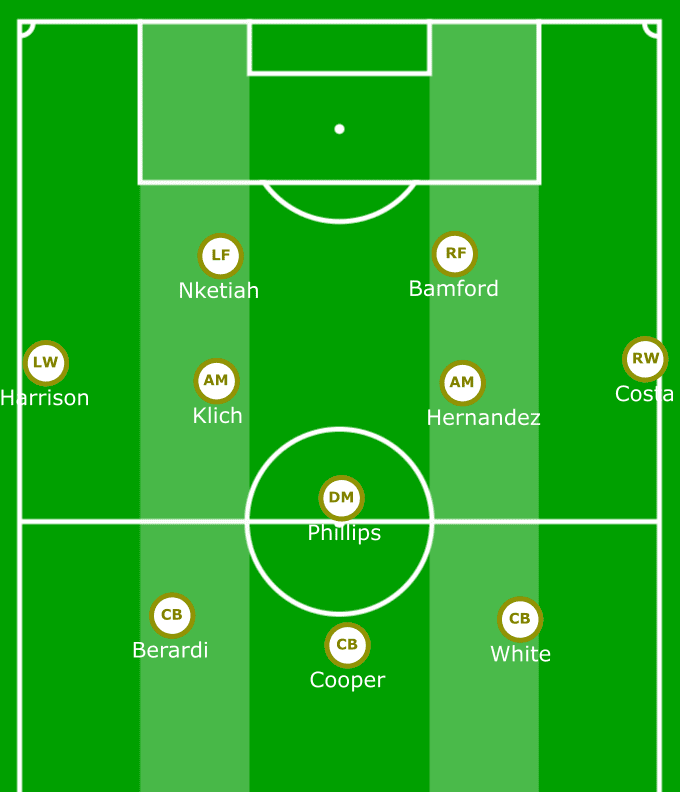
Conclusion
With the winter transfer window approaching soon, Bielsa must find a way to effectively utilise Eddie Nketiah lest he should plan a move elsewhere for the lure of more game time. Patrick Bamford has been unlucky indeed with his chances but can be forgiven for the other aspects he brings to the game. This also means that other players like Harrison, Klich and Costa must share the responsibility of finding the goals for Leeds.
Rafael Benítez famously phrased, “A number nine should be a hungry lion in a cage.” Although the decision to start Bamford or Nketiah as the number nine has its own nuances based on their playing style and contribution to the attacking organisation, if Leeds goal drought continues, it might boil down to which lion at Leeds is hungrier for goals.
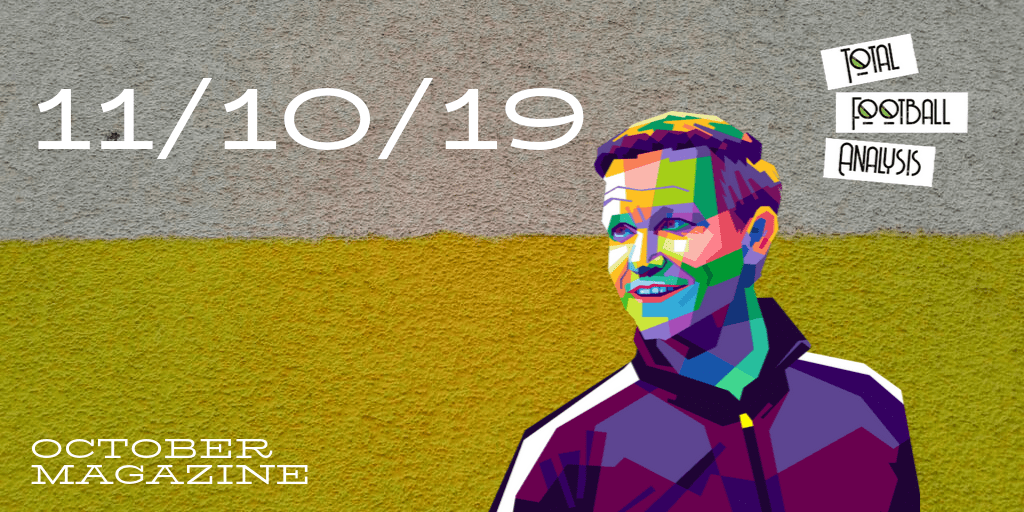
If you love tactical analysis, then you’ll love the digital magazines from totalfootballanalysis.com – a guaranteed 100+ pages of pure tactical analysis covering topics from the Premier League, Serie A, La Liga, Bundesliga and many, many more. Buy your copy of the October issue for just ₤4.99 here





Comments